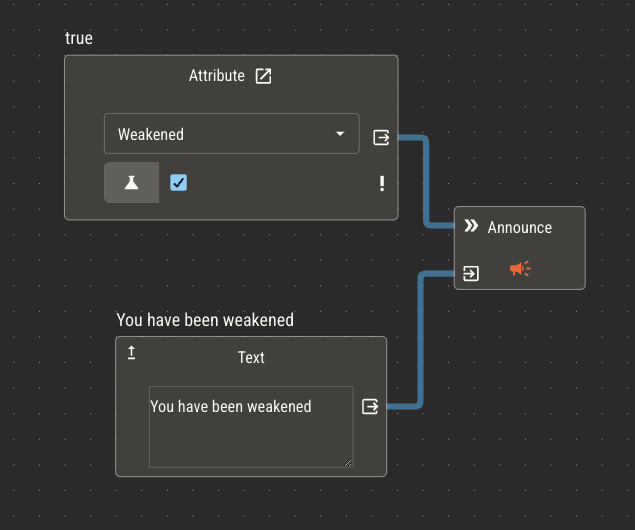Logic And Nodes
Mechanics of your game can be captured within Quest Bound as logic, then used to automate character sheets or the creation of rulebook pages. Logic is added to attributes with the Logic Editor. To edit an attribute's logic, select the logic button in the attribute chart.
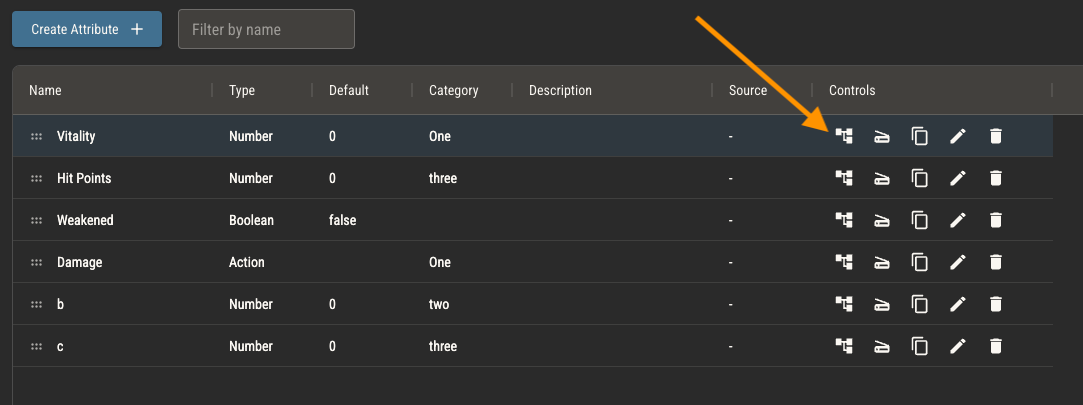
Controlled Values
As described in Intro to Attributes, attributes are variables assigned to entities like characters. Every character has its own copy of attributes which can be controlled from its sheet.
When playing a TTRPG with pen and paper, players are expected to manually update the attributes on their character sheets, erasing and rewriting values as they change.
Sheets in Quest Bound give the same control to players. For every attribute in your ruleset, you can add a field to a sheet which allows players to manually update the value of that attribute.
Controlled attributes do not need logic, but may still benefit from it. For example, you can use logic to clamp an attribute's value between a minimum and maximum while still allowing players to control it.
Derived Values
Suppose you have a number attribute called Max Health. In your game, Max Health is always the value of another number attribute, Vitality, multiplied by a third attribute, Level.
Max Health = Vitality x Level
In this example, Level and Vitality are controlled by the player based on the rules of your game. Max Health, however, is derived from the values of Level and Vitality. It's not something the player should need to change manually.
You can build this automation directly into the Max Health attribute using its logic.
Logic can quickly become complex! For best results, keep it simple and only add logic when automation will greatly benefit your players. Remember that we’re making tabletop games, not video games.
Visual Programming
The Logic Editor allows for visually programming simple instructions. While there are only a handful of operations available, connecting them together allows for very complex instruction sets.
If you’re new to programming concepts, logic can feel overwhelming. Keeping it simple and experimenting will help.
Add a Quest Bound official ruleset to your shelf and check out the logic of several components to get an idea of how it works.
Key Points
There are a few key points to understand about the logic editor before wiring up your first attribute.
Logic is built by adding and connecting nodes
Every node conducts a specific operation. Most nodes provide the result of that operation as their output
Return nodes are used to eject their result outside the current logic, either by assigning it as the attribute's value (primitive attributes), or providing it to other logic (actions)
Mathematical order of operations is not recognized
When the order of nodes matters, nodes placed vertically higher will be considered first
Logic Nodes
Primitives
Primitives are the most basic piece of data within logic. They are static, meaning their values do not change. You may notice that the types of primitives are the same as the types of attributes. This is intentional! When your logic needs one of these values to change based on another value, you can usually achieve that by swapping a primitive with an attribute of the same type.
- Number
- Provides a single number
- Text
- Provides a word or string of words
- Boolean
- Provides a boolean value, true or false
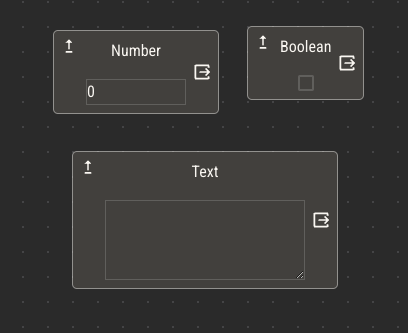
Attribute
Attribute nodes, like primitives, provide either a number, text or boolean value. These nodes supply the value of other attributes.
When logic has an attribute node, it will recalculate its value every time that attribute changes.
You can use the test field within an attribute node to see how your logic operates under different attribute values. This field is only used within the logic editor.
Primitive nodes can be promoted to attributes directly from the logic editor.
Dice
The dice node can be used to hold the value of rolled dice. Dice nodes have a special 'dice select' output, which can be attached to its own statement. The dice select statment should resolve to text in the format of 1d6, where 1 is the number of dice and 6 is the number of sides.
You can add text from multiple nodes, including charts and attributes, to build the dice select statement.
Because dice nodes result in a number, they may be treated the same as number primitives.
Dice nodes produce random numbers every time logic is evaluated. This is usually not desired for derived attributes.
Most of the time you use dice nodes will be within actions.
Operations
Operations are basic math applied to one or two attributes.
The four basic math operations (add, subtract, multiply and divide), perform their operations on all of their inputs, passing the result through its output.
Rounding operations consider their input, passing the rounded value to its output. Round up will always transform its input to the next higher integer, round down the next lowest and round whichever is closer.
Math operations may be swapped to other operations after being placed by clicking their icon.
Comparisons
Comparison nodes consider their input and pass a boolean value to their output. The result of a comparison is always either true or false.

Comparison nodes and boolean nodes can often be used interchangeably because they both always output a boolean.
- Equal
- Resolves to true if its inputs are the same value
- Not Equal
- Resolves to true if its inputs are not the same value
- Greater Than
- Resolves to true if A is greater than B
- This only works for number types
- Less Than
- Resolves to true if A is less than B
- This only works for number types
- Greater Than or Equal
- Resolves to true if A is greater than or equal to B
- This only works for number types
- Less Than or Equal
- Resolves to true if A is less than or equal to B
- This only works for number types
Comparing Booleans
To compare boolean values, you need boolean alegebra operators: AND, OR and NOT.
AND
- Connects multiple booleans
- Resolves to true if all connected statements resolve to true
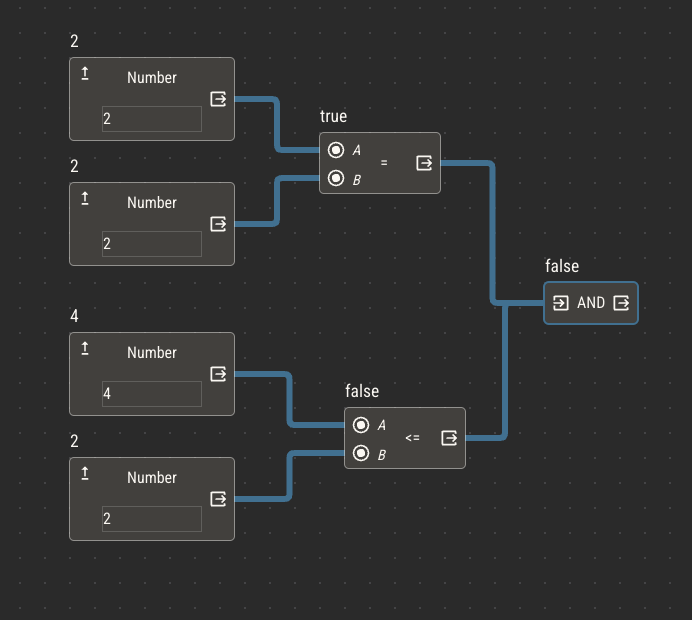
OR
- Connects multiple booleans
- Resolves to true if any connected statment resolves to true

NOT
- Resolves to the opposite of its input
Conditions
- If
- Splits logic into two possible branches based on a boolean value
- If true, it passes its input to the true branch
- If false, it passes its input to the false branch
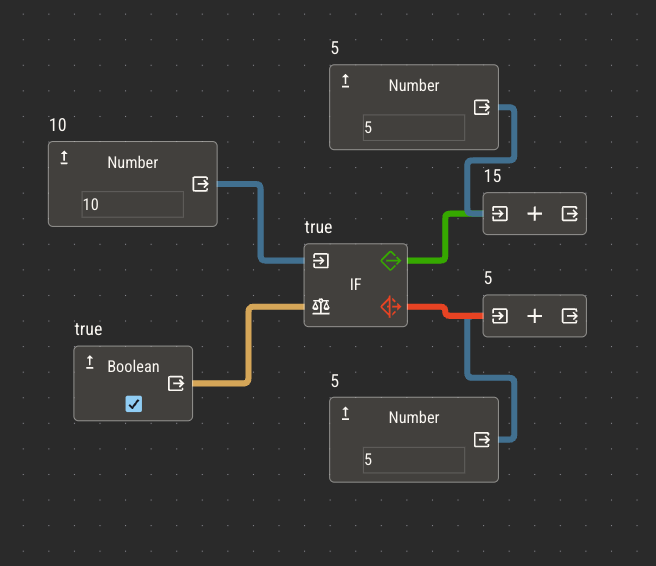
Notice that the add node on the false branch has a value of 5 instead of 15. This is because the if node did not pass its input, given that the connected boolean was true.
Conditions without Inputs
Some nodes, like return and side effect, have a special input that controls their execution. When nothing is connected, these nodes will always excute, but when a connection is made, only a true value will let them execute.
By connecting if nodes to these inputs, you can control when a value is returned or when a side effect is executed via branching logic.
Variables
In primitive attributes, variable nodes can be used to hold local values that can be referenced within that attribute's logic only. This can be useful if you need to calculate a value within an attribute's logic and use it multiple times.
Variable nodes have a text field for naming the variable and an output to connect to a statement. Variable nodes without inputs will take the value of the first other variable it finds with its name.
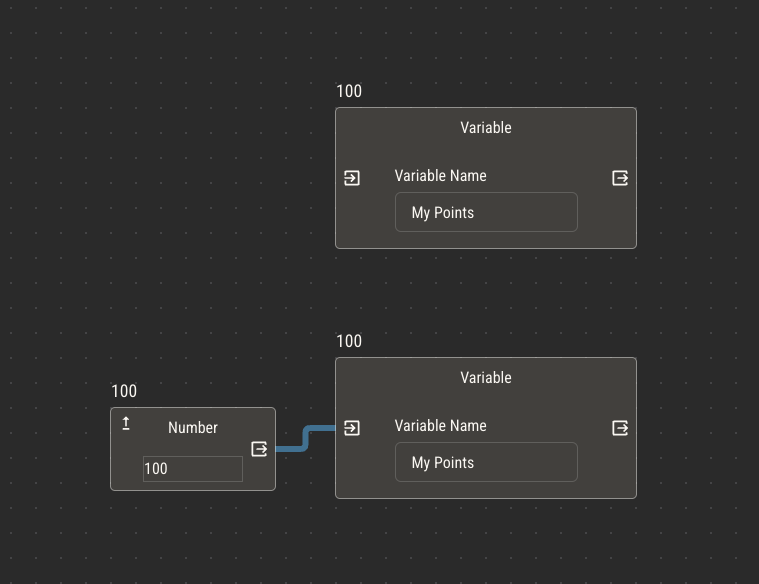
Variable nodes are also used to provide parameters to actions.
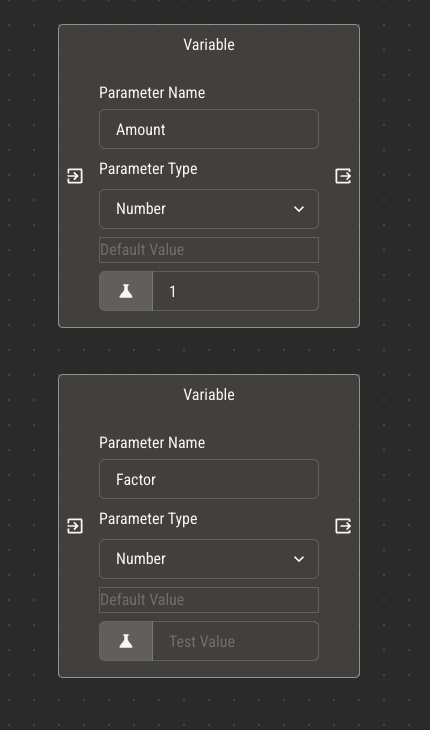
Chart
The chart node can read a chart and return the value of a single cell.
Chart nodes connect to a comparison. It will scan every row of the chart, returning the value of the selected column for the first row that passing the comparison.
Read more about how this works on the chart page.

Default Value
The default value node provides a way to control the default value of the attribute. Note that it may also be controlled from the attribute chart.
This node will also output the attribute's current default value and provide inputs for clamping the attribute to a minimum and maximum value.
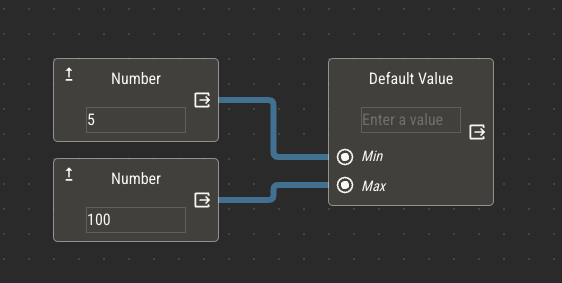
Return
Return nodes store the ultimate resolution of the logic, if there is one. In primitive attributes, the first return node to execute will set the derived value of that attribute.
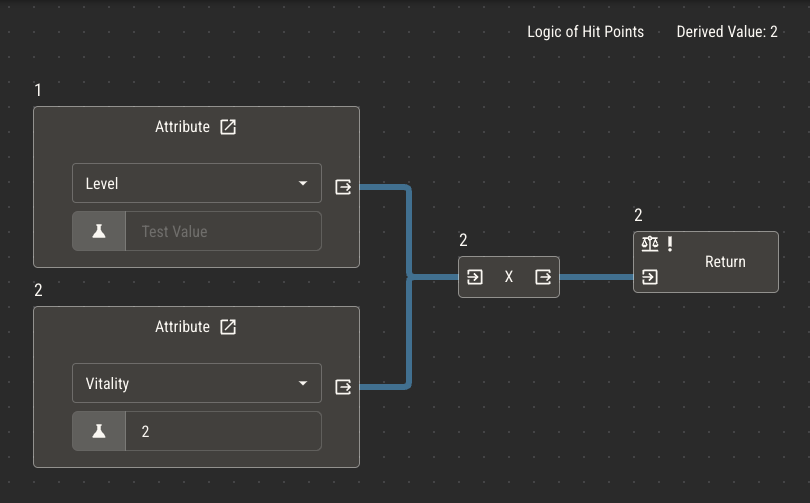
In actions, return nodes provide the result of the action in other attributes.
Comment
Comments are notes left within logic to help with explaining or remembering it. They don't affect the execution of the logic whatsoever.
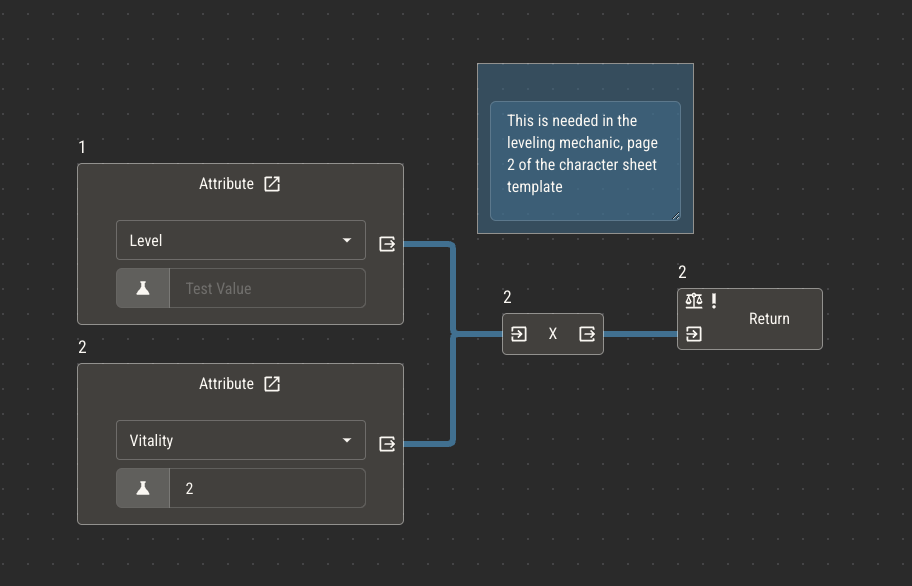
Announce
Announce nodes will create in-app notifications to alert your players to some event. The notification will have the text content provided to its input and will only appear if the connected condition is true.
